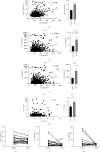Laboratory Predictors of COVID-19 Mortality: A Retrospective Analysis from Tongji Hospital in Wuhan
- PMID: 33679237
- PMCID: PMC7906000
- DOI: 10.1155/2021/6687412
Laboratory Predictors of COVID-19 Mortality: A Retrospective Analysis from Tongji Hospital in Wuhan
Abstract
Background: Novel coronavirus disease 2019 (COVID-19), an acute respiratory disease caused by severe acute respiratory syndrome coronavirus 2 (SARS-CoV-2), rapidly progressed to a global pandemic. Currently, there are limited effective medications approved for this deadly disease.
Objective: To investigate the potential predictors of COVID-19 mortality and risk factors for hyperinflammation in COVID-19.
Methods: Retrospective analysis was carried out in 1,149 patients diagnosed with COVID-19 in Tongji Hospital, Wuhan, China, from 1/13/2020 to 3/15/2020.
Results: We found significant differences in the rates of hyperuricemia (OR: 3.17, 95% CI: 2.13-4.70; p < 0.001) and hypoalbuminemia (OR: 5.68, 95% CI: 3.97-8.32; p < 0.001) between deceased and recovered patients. The percentages of hyperuricemia in deceased patients and recovered patients were 23.6% and 8.9%, respectively, which were higher than the reported age-standardized prevalence of 6.2% in Chinese population. Of note, the percentages of both IL-6 and uric acid levels in survived COVID-19 patients were above 90%, suggesting that they might be good specificity for indicators of mortality in COVID-19 patients. The serum level of uric acid (UA) was positively associated with ferritin, TNF-α, and IL-6 but not with anti-inflammatory cytokine IL-10. In addition, the levels of these proinflammatory cytokines in COVID-19 patients showed a trend of reduction after uric acid lowering therapy.
Conclusions: Our results suggest that uric acid, the end product of purine metabolism, was increased in deceased patients with COVID-19. In addition, the serum level of uric acid was positively associated with inflammatory markers. Uric acid lowering therapy in COVID-19 patients with hyperuricemia may be beneficial.
Copyright © 2021 Ting Zheng et al.
Conflict of interest statement
The authors declare no conflicts of interest.
Figures

Similar articles
-
Cytokines and their relationship with the severity and prognosis of coronavirus disease 2019 (COVID-19): a retrospective cohort study.BMJ Open. 2020 Nov 30;10(11):e041471. doi: 10.1136/bmjopen-2020-041471. BMJ Open. 2020. PMID: 33257492 Free PMC article.
-
Clinical Characteristics and Immune Responses of 137 Deceased Patients With COVID-19: A Retrospective Study.Front Cell Infect Microbiol. 2020 Dec 7;10:595333. doi: 10.3389/fcimb.2020.595333. eCollection 2020. Front Cell Infect Microbiol. 2020. PMID: 33365277 Free PMC article.
-
Profiling serum cytokines in COVID-19 patients reveals IL-6 and IL-10 are disease severity predictors.Emerg Microbes Infect. 2020 Dec;9(1):1123-1130. doi: 10.1080/22221751.2020.1770129. Emerg Microbes Infect. 2020. PMID: 32475230 Free PMC article.
-
Maternal and infant outcomes of full-term pregnancy combined with COVID-2019 in Wuhan, China: retrospective case series.Arch Gynecol Obstet. 2020 Sep;302(3):545-551. doi: 10.1007/s00404-020-05573-8. Epub 2020 Jul 21. Arch Gynecol Obstet. 2020. PMID: 32696241 Free PMC article. Review.
-
Hemoperfusion and blood purification strategies in patients with COVID-19: A systematic review.Artif Organs. 2021 Dec;45(12):1466-1476. doi: 10.1111/aor.14078. Epub 2021 Oct 10. Artif Organs. 2021. PMID: 34632596 Free PMC article.
Cited by
-
The Evaluation of New-Generation Biomarker sCD14ST Provides New Insight into COVID-19's Effect on Bone Remodeling.J Clin Med. 2025 Feb 3;14(3):979. doi: 10.3390/jcm14030979. J Clin Med. 2025. PMID: 39941649 Free PMC article.
-
SCD14-ST and New Generation Inflammatory Biomarkers in the Prediction of COVID-19 Outcome.Biomolecules. 2022 Jun 13;12(6):826. doi: 10.3390/biom12060826. Biomolecules. 2022. PMID: 35740951 Free PMC article.
-
Mortality predictors in patients with COVID-19 pneumonia: a machine learning approach using eXtreme Gradient Boosting model.Intern Emerg Med. 2022 Oct;17(7):1929-1939. doi: 10.1007/s11739-022-03033-6. Epub 2022 Sep 13. Intern Emerg Med. 2022. PMID: 36098861 Free PMC article.
-
Dysuricemia-A New Concept Encompassing Hyperuricemia and Hypouricemia.Biomedicines. 2023 Apr 23;11(5):1255. doi: 10.3390/biomedicines11051255. Biomedicines. 2023. PMID: 37238926 Free PMC article. Review.
-
Prevalence and Outcomes Associated with Hyperuricemia in Hospitalized Patients with COVID-19.Am J Nephrol. 2022;53(1):78-86. doi: 10.1159/000520355. Epub 2021 Dec 9. Am J Nephrol. 2022. PMID: 34883482 Free PMC article.
References
-
- WHO coronavirus disease (COVID-19) dashboard. October 2020, https://covid19.who.int/?gclid=CjwKCAjwq832BRA5EiwACvCWsUXTxEZePK3xTjFXs....
MeSH terms
Substances
LinkOut - more resources
Full Text Sources
Other Literature Sources
Medical
Miscellaneous

